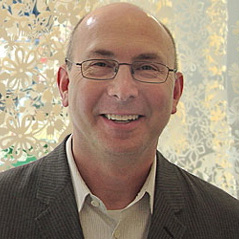
dezeen interviews... Murray Moss
Dezeen caught up with legendary New York design retailer and gallerist Murray Moss at Design Miami last month.
We spoke to him about the way boundaries between design and craft are blurring, talked about the influence of Design Academy Eindhoven on the current wave of Dutch designers, and asked him how his collaborations with Maarten Baas came about.
Dezeen: At lot of the work you’re championing at the moment is by figures such as Hella Jongerius, Claudy Jongstra, Tord Boontje and Maarten Baas. But is it design or is it craft?
MM: I don’t know, but there’s been this seismic change. I remember when people had to declare – like the old, ancient guild system – what their trade was. And in more recent times one of the trades was industrial designer. And another was craftsman, or artist, or glassblower, or weaver.
And now people have multiple guilds, multiple trades, and they begin to combine then in a way that changes the definition of industry or industrially produced, or let’s say expanding what that means, in the same way they’re changing the definition of what it means to be a craftsman. They’re not staying in their boxes.
Let’s call it a multi-media approach. Which has happened in other art forms. Whereby Hella [Jongerius] can work with an industrialist and have an industrialist’s dialogue and at the same time work things in her studio and either combine them, or have a sort of duality.
Tord Boontje is an example of someone who will cut something out of paper as a one-off and then direct it to be produced for $50 with a laser-cut. They’re not staying put in their particular disciplines and they’re multi-talented, and I think that’s very wonderful.
Our job is to take the lead from the people who are making the work, and the people who are making the work are very comfortable working in multiples, working as one-off pieces, working with combinations thereof, so the idea of industrial has an anarchy to it.
Some pieces can be completely machine made, some pieces can be entirely hand-crafted, some pieces can be a combination. All those options are now open. It’s throwing craftsmen into conversations with industrialists and vice-versa.
Dezeen: Where did you first come across Maarten Baas’ work?
MM: I was in Milan – I forget the year – during the Salone del Mobile. Design Academy Eindhoven was doing a show and I saw his chair, which he calls the Baroque chair [an early example of his Smoke range of burnt furniture] but which is really a kind of Victorian chair (below). Burnt. An anonymous piece.
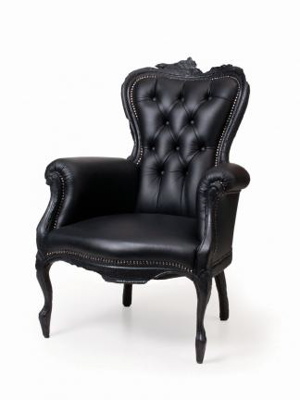
Naturally it had huge resonance. It just really stuck in my mind. So I called him after the fair when I was back in New York and asked him if we could meet. I just wanted to talk with him in person about it, which is not something that often happens to me, or occurs to me to do.
So my next trip to Europe I was in Paris; I asked if he would fly over and have breakfast with me, so we could talk about it. So I asked him, I said I don’t want to put words in your mouth, but here’s what I think’s going on, could you just tell me if that’s full of shit or is that’s actually there, because I have a question.
So he said yes, that’s actually there; some of it was on the surface of my mind and some of it wasn’t, but yes. So it was about learning, Smoke. It’s not a nihilistic act, it’s actually an ingestion of an idea, showing how a student starting as an empty vessel takes in information, is influenced by something - music, fashion, architectuure – these ideas go through us and almost chemically change us.
And what comes out of us as our own ideas is a sort of compliation, evolution of what we’ve learned. In most cases that’s kind of subtle or in a negative sense serreptitious – people will say that’s very similar to something I saw by Alvar Aalto – but in Maarten’s case there was such a clear metaphor. You take something and you actually caress it with your hands, with flame. You actually alter it chemically, like eating it, ingesting it. It becomes a part of you, recognisable in its original form but also reborn as a work of yours.
So when he re-signatures it, he takes a [Dutch de Stijl designer Gerrit] Rietveld piece and puts “Baas" on it. It’s actually an incredibly truthful statement about how we evolve. We climb. There’s a recognition of what came before. And the fact that it went through a chemical change is a beautiful metaphor. And in fact the limited edition like the piece we have now, of Gijs Bakker, began as number 4 of a limited edition by Gijs Bakker and has now been re-edited as number 1 of Maarten Baas.
So I asked him to forgo the anonymity and asked how he would feel about burning his education. All the things that were important and influential to him and had gone through him - could we actually illustrate that, show that, by burning those pieces.
So in that first collection [Where’s There’s Smoke, presented at the Moss store in New York in May 2004] we burnt a Sottsass piece, we burnt a Tejo Remy (below) - who was his teacher - we burnt Eames pieces, Gaudi pieces. I thought it was very important we created the idea that there would be generations of Where There’s Smoke.
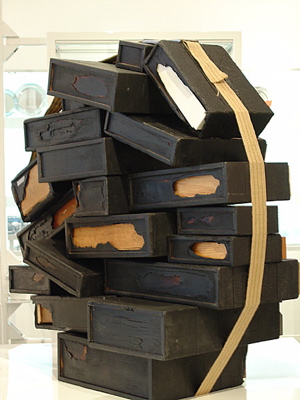
So this year it’s Where There’s Smoke 06, so he takes Reitveld, he takes Gijs Bakker, there’s an Eames piece - and it’s evolved now, because he actually took a functional piece [a leg splint designed by Charles and Ray Eames in 1943] and turned it into a figurative piece (below). We mounted it as if it was an African mask.
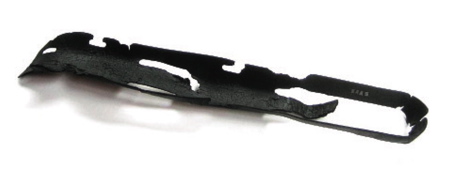
So there’s a movement. And then of course the Clay pieces. Maarten was very afraid, because his first gesture that was recognised was so powerful – I don’t want to put words in his mouth – but he was concerned that that would be it: you’re the smoke guy, you’re the burning guy. And I think that was agony. Because rarely does it begin so powerfully.
So then I looked at the Clay and I thought oh my god, it’s an interesting idea. It’s a life study – he actually takes the idea of a chair and with his hands makes a classic or iconic chair. As much as a person would paint, if you set out to paint an iconic chair, it would be infused with your own brush stroke, it’s the same with what he’s doing with his hands. And actually the second body of work, like the first, which is Maarten caressing something, firstly with the flame and now with the clay. It is a similar approach. And also a total, immediate clarity of thought.
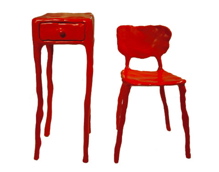
Dezeen: The process of creating Smoke and Clay – is that a craft process or a design process?
MM: Well I think it’s an industrial process – because we’re talking about welding metal, using industrial processes, but the industrialist in this case happens to be the studio. I think Gaetano Pesce already years ago, four decades ago, changed the definition of industrial by saying industrial is a very elastic term.
By definition of the material [Pesce] uses – which is liquid resin – and the process – which is pouring it – it’s an industrial process - pouring it in to a mould – but by definition of that process, the particulars of that process and that material, you have an industrial process producing one-off pieces.
Dezeen: How unusual is it for someone to emerge from college with such a powerful idea?
MM: It’s exceptional. I can’t think of another example where an idea – and it isn’t that Maarten has a style – it’s as if somebody wrote a piece of music that’s totally clear, concise, consistent. Beautiful, and laden with content. Not messy. And also a form-giving process. And a conceptual idea. And there’s actually a new technique for producing something. So producing something and altering it chemically by flame is one example, and to do a still life of an inanimate object with clay is another.
Dezeeeen: Maarten, Claudy, Hella, Tord – they’re all Dutch. Is there something particularly Dutch about this?
MM: I think, without being simplistic, an obvious reason is that people are coming from Design Academy Eindhoven. And as it has been throughout time, when there’s a particular school or school of thought, occuring anywhere in the world, it’s like ringing a bell; it has tremendous reverberations. Eindhoven is the most brilliant design school we have today. It has an effect much larger than would be believed.
So I don’t think it’s in any way coincidental that what’s coming from the Netherlands is so good. Also of course as a sidebar there is the support from the government, allowing people to begin studios, considering it to be a totally possible way for having a life, by becoming a designer or an artist, rather than the horrific approach which would mean instant doom and gloom.
And there’s financial support from the Dutch government and the Mondriaan Foundation. They were incredibly supportive of us at the beginning and continue to be wildly supportive. And it works. That’s very very crtical part of the occasion.
Dezeeeeen: What happens in the teaching process at Eindhoven that allows this?
MM: First of all it’s the dialogue between the teachers there – people like Marcel Wanders, Hella, Ilse Crawford, and the students. It has to do with the fact that the terminology – it’s a subtle thing but they changed the terminology of what design is. So the courses were completely reinvented with different briefs which are so broad, they open a door rather than close a door. It’s a very expansive way of working. It’s very creative, it’s almost like one large studio.
And very craft-oriented. People make things at Eindhoven. They don’t push a mouse at a computer. When I go to Eindhoven people are making things. But they’re not ingorant of the industrial process and they’re not scared of it, and they know who to talk to, which is part of the dialogue that occurs at Eindhoven.
And they are very open – they take the students work to the middle of the world’s largest design fair [Milan] and they show it. So they put people in the context of marketplace, even though it’s coming from a very personal point of view. That’s a simple action but schools don’t really do that.
> More dezeen stories on Moss here and here